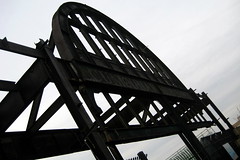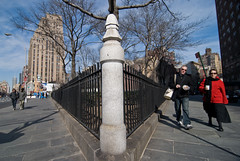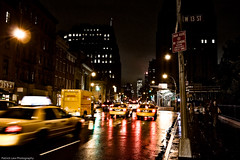South:
60: Village House apartments; at this
address in 1897 the Boys' High School opened,
the first New York public high school for boys.
It later becomes De Witt Clinton High School.
54: Was La Dolce Vita, Italian, and
Taste of Tokyo, a John Lennon/Yoko Ono hangout,
closed 2007, demolished 2008, scheduled to be replaced by a
glass highrise by 2009.
50: Founded 1972, this theater features
the longest-running off-off-Broadway play: Israel
Horowitz's Line, which started here in 1974.
Bette Midler and Chazz Palminteri played here early
in their careers. The building is said to date to the
late 18th Century and to have served as a stop on the
Underground Railroad.
Now
threatened with demolition.
42: The Bakery Building
40: From 1898-1999, this gothic
archway marked the
Rambusch studios. Originally
specializing in stained glass for churches,
this firm was also responsible for the interiors
of some of the country's most opulent movie
palaces, including New York's Roxy and Beacon.
It's now the
Jewish Enrichment Center's Reunion,
home of Birthright Israel Next: New York.
36: International Tae Kwon Do Center

34: Manhattan's first multiplex shows art films,
somewhere between Angelica and Film Forum in quirkiness.
30: Filaments, antique and custom lamps
10: Was Cinemabilia, movie-themed bookstore where Tom Verlaine and Richard Hell worked in their pre-Television days.
8: Kate's Paperie, fancy stationery
store, founded 1988.

2: A prominent art and design school founded 1896,
now part of the New School; Norman Rockwell, Edward Hopper,
Jasper Johns, Donna Karan and Isaac Mizrahi are all alums. Muralists
Diego Rivera and
Thomas Hart Benton both lived
at this address in the 1930s.
Max Eastman lived here from the mid-1940s until his death in 1969.
| 


